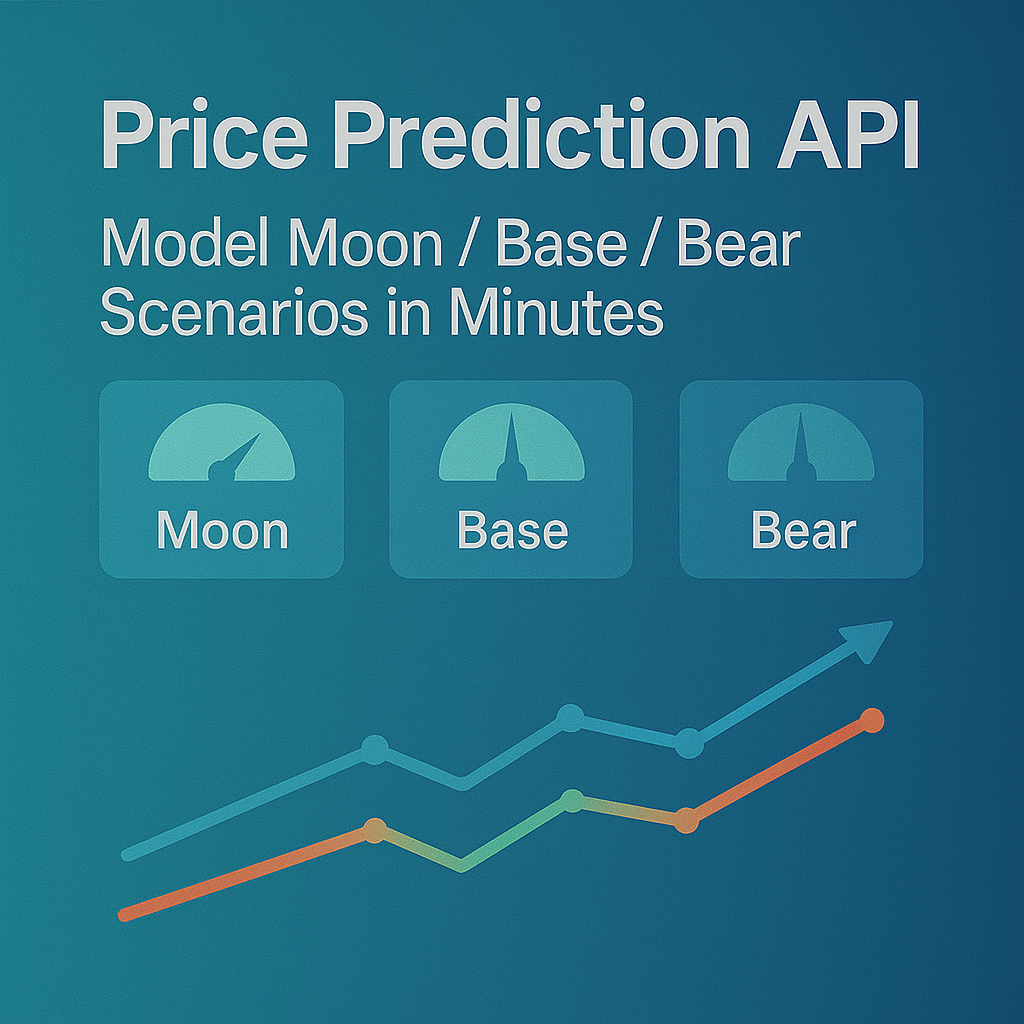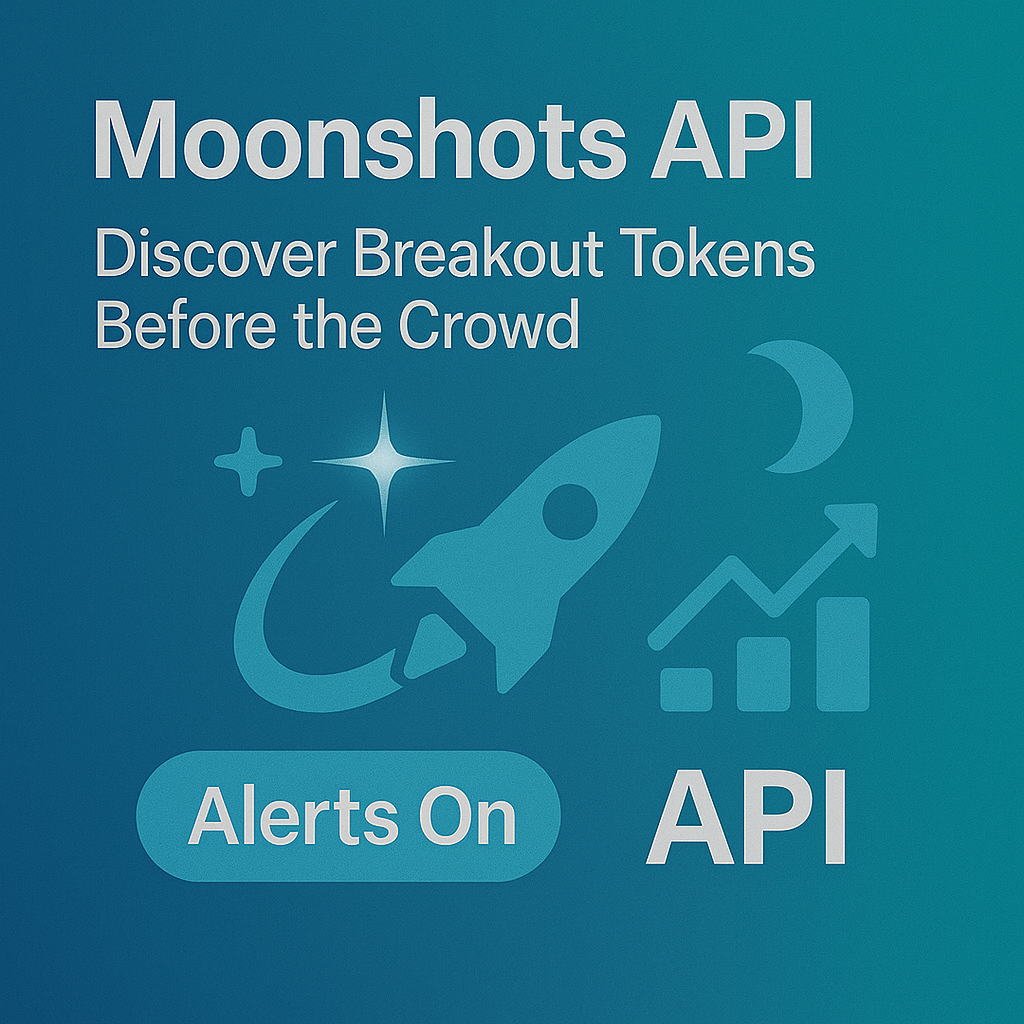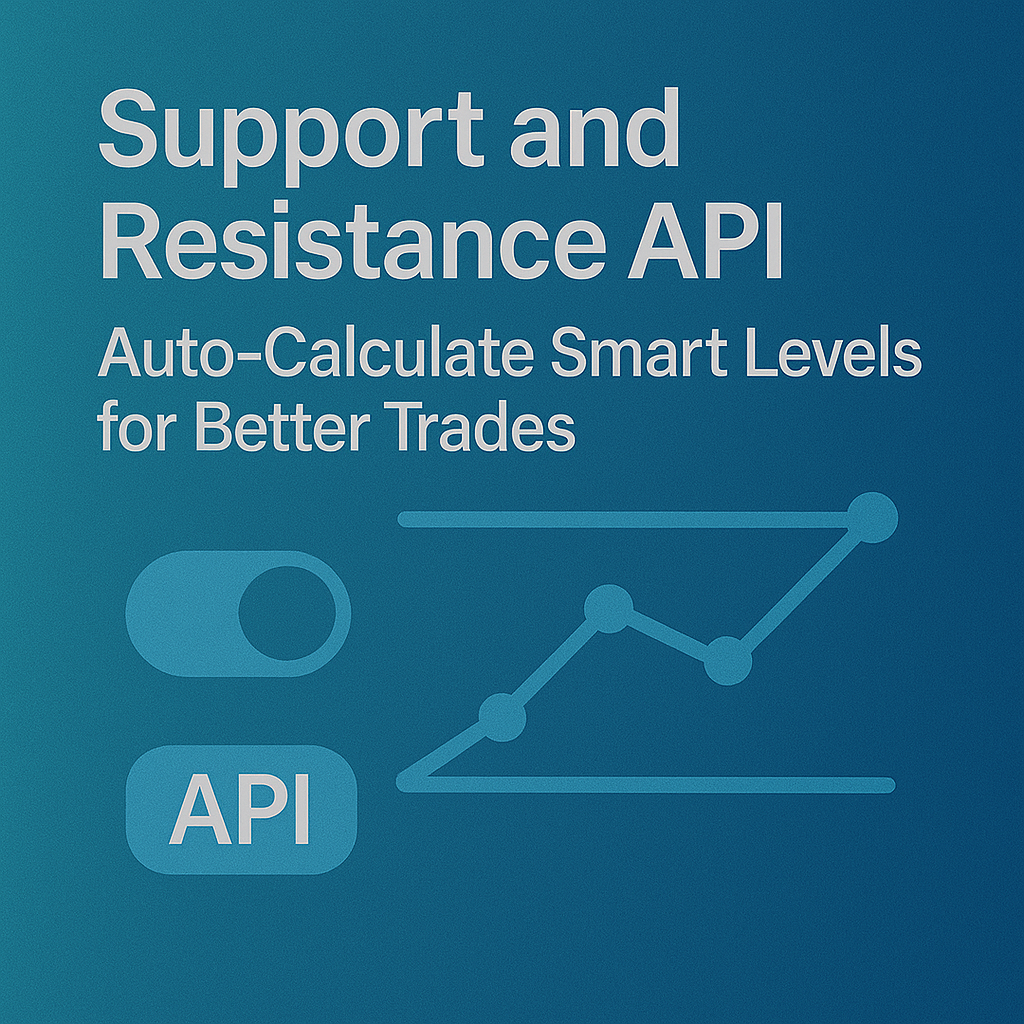Top Crypto Trading Platforms in 2025







%201.svg)
%201.svg)
Big news: We’re cranking up the heat on AI-driven crypto analytics with the launch of the Token Metrics API and our official SDK (Software Development Kit). This isn’t just an upgrade – it's a quantum leap, giving traders, hedge funds, developers, and institutions direct access to cutting-edge market intelligence, trading signals, and predictive analytics.
Crypto markets move fast, and having real-time, AI-powered insights can be the difference between catching the next big trend or getting left behind. Until now, traders and quants have been wrestling with scattered data, delayed reporting, and a lack of truly predictive analytics. Not anymore.
The Token Metrics API delivers 32+ high-performance endpoints packed with powerful AI-driven insights right into your lap, including:
Getting started with the Token Metrics API is simple:
At Token Metrics, we believe data should be decentralized, predictive, and actionable.
The Token Metrics API & SDK bring next-gen AI-powered crypto intelligence to anyone looking to trade smarter, build better, and stay ahead of the curve. With our official SDK, developers can plug these insights into their own trading bots, dashboards, and research tools – no need to reinvent the wheel.
%201.svg)
%201.svg)
The biggest gains in crypto rarely come from the majors. They come from Moonshots—fast-moving tokens with breakout potential. The Moonshots API surfaces these candidates programmatically so you can rank, alert, and act inside your product. In this guide, you’ll call /v2/moonshots, display a high-signal list with TM Grade and Bullish tags, and wire it into bots, dashboards, or screeners in minutes. Start by grabbing your key at Get API Key, then Run Hello-TM and Clone a Template to ship fast.
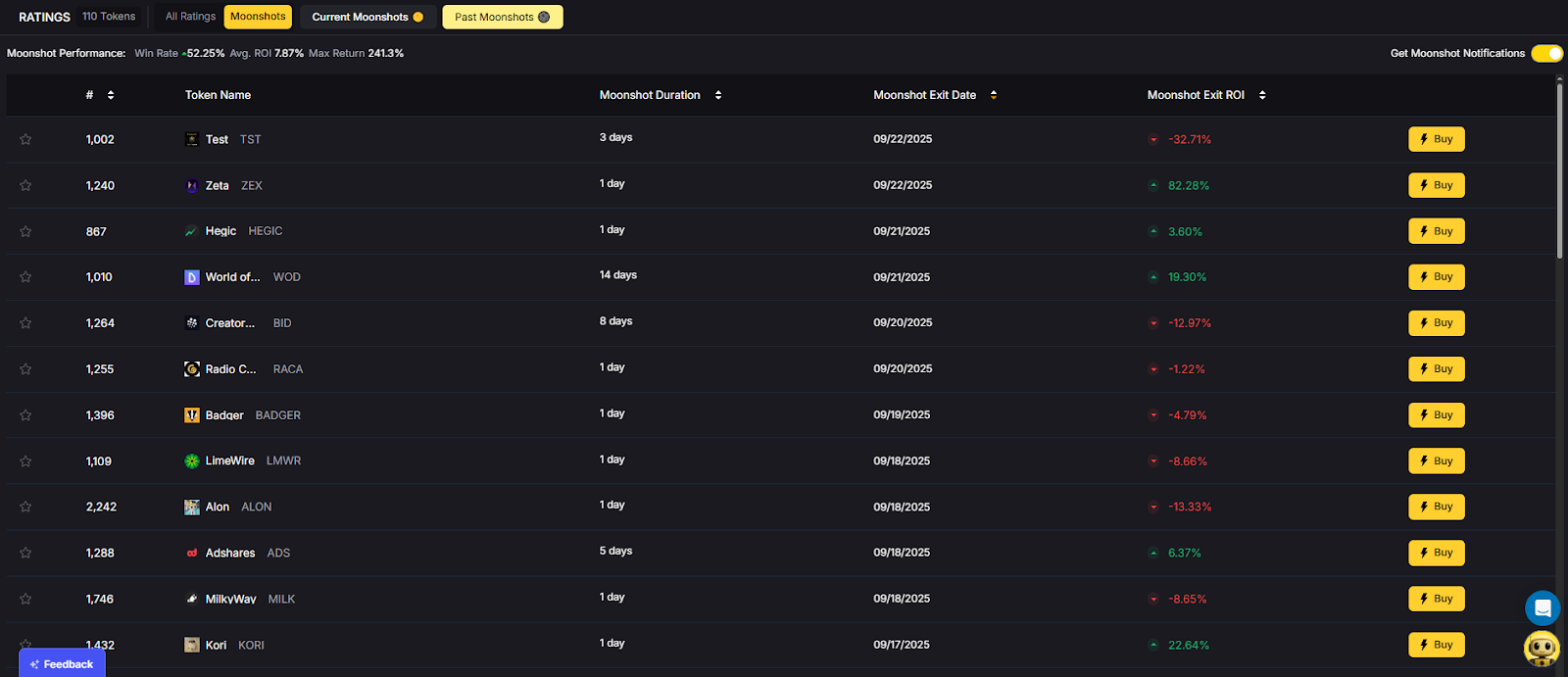
Discovery that converts. Users want more than price tickers—they want a curated, explainable list of high-potential tokens. The moonshots API encapsulates multiple signals into a short list designed for exploration, alerts, and watchlists you can monetize.
Built for builders. The endpoint returns a consistent schema with grade, signal, and context so you can immediately sort, badge, and trigger workflows. With predictable latency and clear filters, you can scale to dashboards, mobile apps, and headless bots without reinventing the discovery pipeline.
The Moonshots API cURL request is right there in the top right of the API Reference. Grab it and start tapping into the potential!
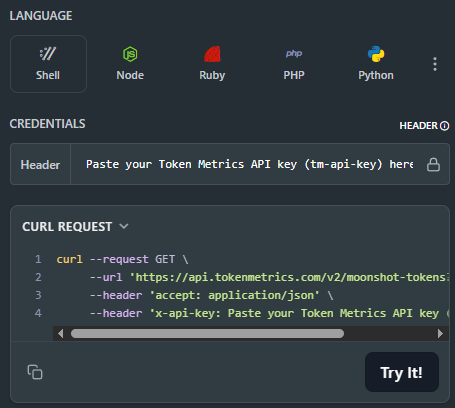
👉 Keep momentum: Get API Key • Run Hello-TM • Clone a Template
Fork a screener or alerting template, plug your key, and deploy. Validate your environment with Hello-TM. When you scale users or need higher limits, compare API plans.
The Moonshots endpoint aggregates a set of evidence—often combining TM Grade, signal state, and momentum/volume context—into a shortlist of breakout candidates. Each row includes a symbol, grade, signal, and timestamp, plus optional reason tags for transparency.
For UX, a common pattern is: headline list → token detail where you render TM Grade (quality), Trading Signals (timing), Support/Resistance (risk placement), Quantmetrics (risk-adjusted performance), and Price Prediction scenarios. This lets users understand why a token was flagged and how to act with risk controls.
Polling vs webhooks. Dashboards typically poll with short-TTL caching. Alerting flows use scheduled jobs or webhooks (where available) to smooth traffic and avoid duplicates. Always make notifications idempotent.
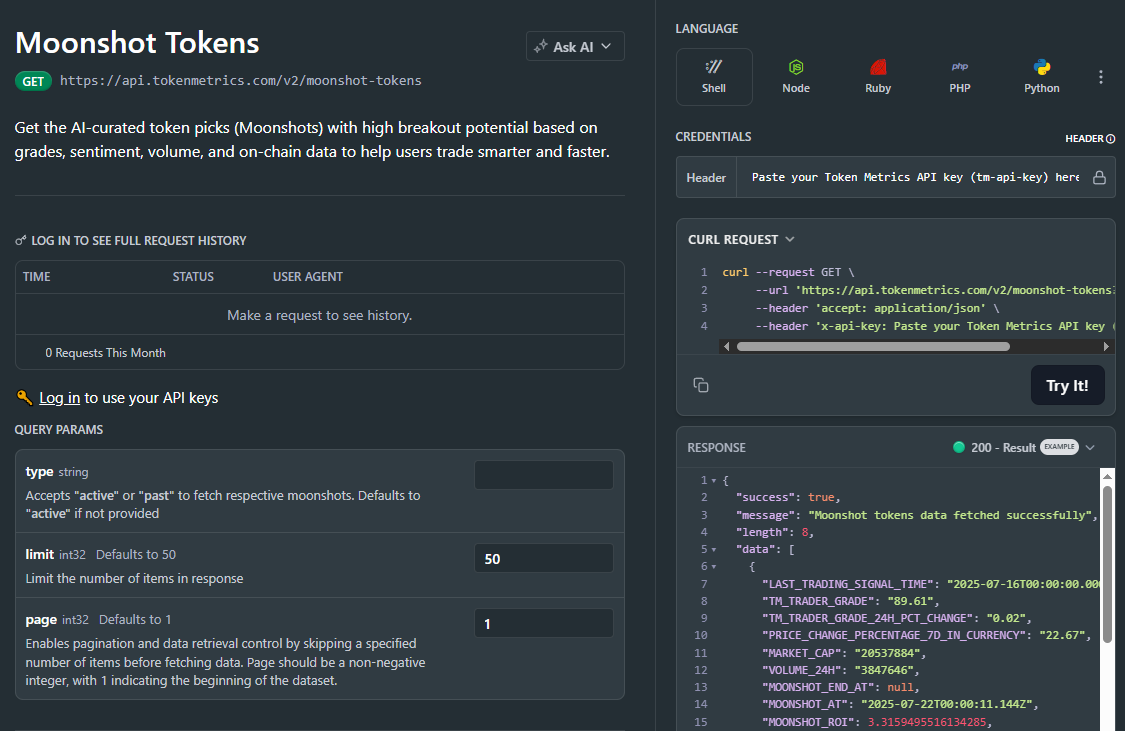
1) What does the Moonshots API return?
A list of breakout candidates with fields such as symbol, tm_grade, signal (often Bullish/Bearish), optional reason tags, and updated_at. Use it to drive discover tabs, alerts, and watchlists.
2) How fresh is the list? What about latency/SLOs?
The endpoint targets predictable latency and timely updates for dashboards and alerts. Use short-TTL caching and queued jobs/webhooks to avoid bursty polling.
3) How do I use Moonshots in a trading workflow?
Common stack: Moonshots for discovery, Trading Signals for timing, Support/Resistance for SL/TP, Quantmetrics for sizing, and Price Prediction for scenario context. Always backtest and paper-trade first.
4) I saw results like “+241%” and a “7.5% average return.” Are these guaranteed?
No. Any historical results are illustrative and not guarantees of future performance. Markets are risky; use risk management and testing.
5) Can I filter the Moonshots list?
Yes—pass parameters like min_grade, signal, and limit (as supported) to tailor to your audience and keep pages fast.
6) Do you provide SDKs or examples?
REST works with JavaScript and Python snippets above. Docs include quickstarts, Postman collections, and templates—start with Run Hello-TM.
7) Pricing, limits, and enterprise SLAs?
Begin free and scale up. See API plans for rate limits and enterprise options.
%201.svg)
%201.svg)
Most traders still draw lines by hand in TradingView. The support and resistance API from Token Metrics auto-calculates clean support and resistance levels from one request, so your dashboard, bot, or alerts can react instantly. In minutes, you’ll call /v2/resistance-support, render actionable levels for any token, and wire them into stops, targets, or notifications. Start by grabbing your key on Get API Key, then Run Hello-TM and Clone a Template to ship a production-ready feature fast.
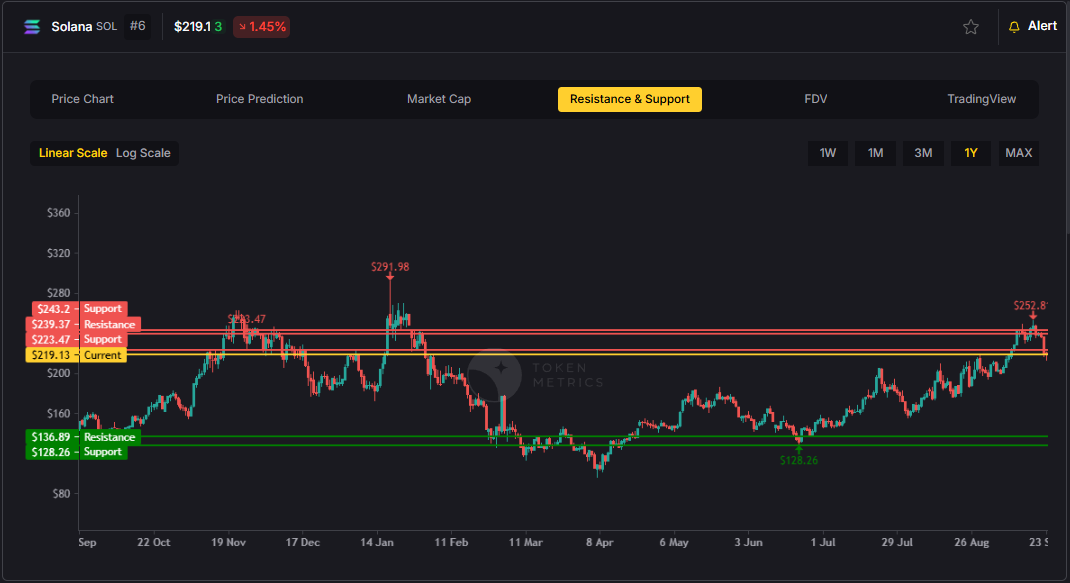
Precision beats guesswork. Hand-drawn lines are subjective and slow. The support and resistance API standardizes levels across assets and timeframes, enabling deterministic stops and take-profits your users (and bots) can trust.
Production-ready by design. A simple REST shape, predictable latency, and clear semantics let you add levels to token pages, automate SL/TP alerts, and build rule-based execution with minimal glue code.
Need the Support and Resistance data? The cURL request for it is in the top right of the API Reference for quick access.
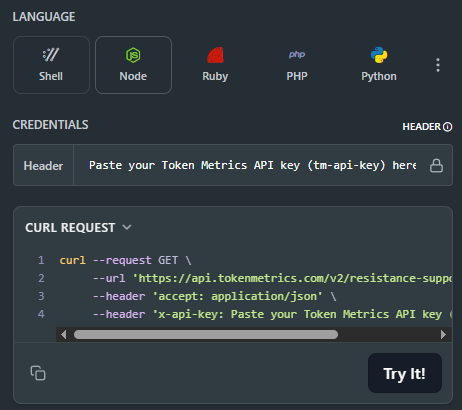
👉 Keep momentum: Get API Key • Run Hello-TM • Clone a Template
Kick off with our quickstarts—fork a bot or dashboard template, plug your key, and deploy. Confirm your environment by Running Hello-TM. When you’re scaling or need webhooks/limits, review API plans.
The Support/Resistance endpoint analyzes recent price structure to produce discrete levels above and below current price, along with strength indicators you can use for priority and styling. Query /v2/resistance-support?symbol=<ASSET>&timeframe=<HORIZON> to receive arrays of level objects and timestamps.
Polling vs webhooks. For dashboards, short-TTL caching and batched fetches keep pages snappy. For bots and alerts, use queued jobs or webhooks (where applicable) to avoid noisy, bursty polling—especially around market opens and major events.
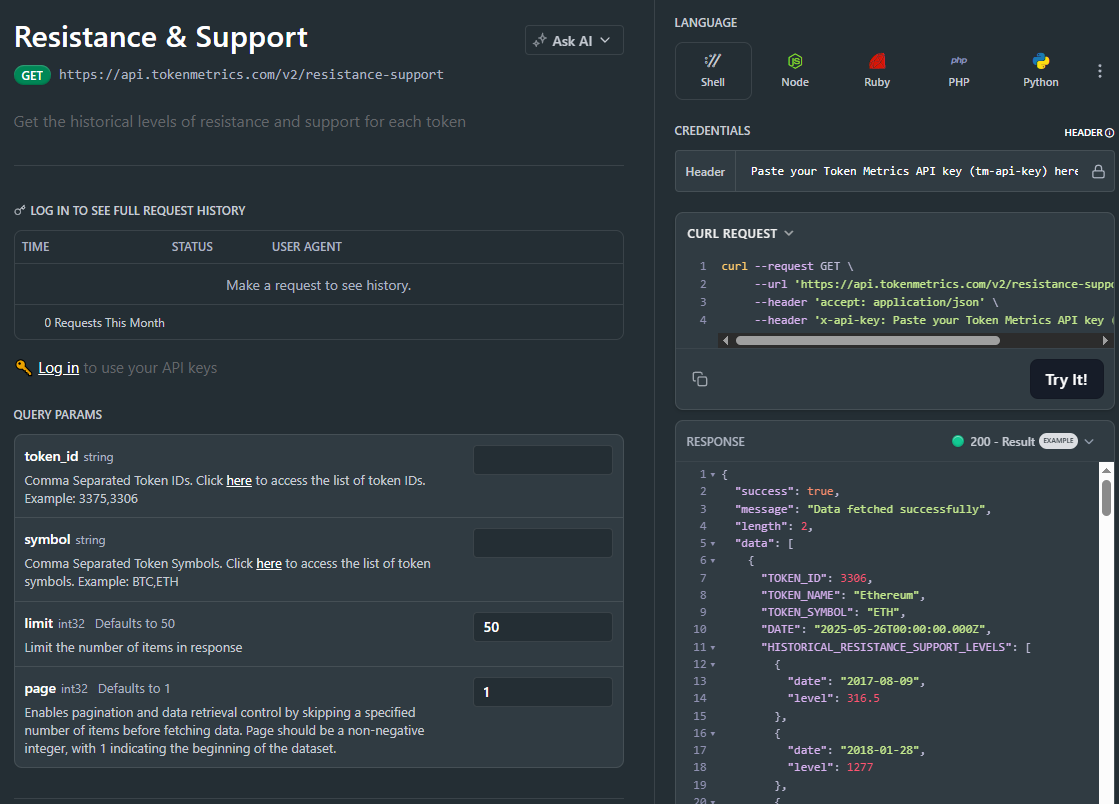
1) What does the Support & Resistance API return?
A JSON payload with arrays of support and resistance levels for a symbol (and optional timeframe), each with a price and strength indicator, plus an update timestamp.
2) How timely are the levels? What are the latency/SLOs?
The endpoint targets predictable latency suitable for dashboards and alerts. Use short-TTL caching for UIs, and queued jobs or webhooks for alerting to smooth traffic.
3) How do I trigger alerts or trades from levels?
Common patterns: alert when price is within X% of a level, touches a level, or breaks beyond with confirmation. Always make downstream actions idempotent and respect rate limits.
4) Can I combine levels with other endpoints?
Yes—pair with /v2/trading-signals for timing, /v2/tm-grade for quality context, and /v2/quantmetrics for risk sizing. This yields a complete decide-plan-execute loop.
5) Which timeframe should I use?
Intraday bots prefer shorter horizons; swing/position dashboards use daily or higher-timeframe levels. Offer a timeframe toggle and cache results per setting.
6) Do you provide SDKs or examples?
Use the REST snippets above (JS/Python). The docs include quickstarts, Postman collections, and templates—start with Run Hello-TM.
7) Pricing, limits, and enterprise SLAs?
Begin free and scale as you grow. See API plans for rate limits and enterprise SLA options.
%201.svg)
%201.svg)
Most traders see price—quants see probabilities. The Quantmetrics API turns raw performance into risk-adjusted stats like Sharpe, Sortino, volatility, drawdown, and CAGR so you can compare tokens objectively and build smarter bots and dashboards. In minutes, you’ll query /v2/quantmetrics, render a clear performance snapshot, and ship a feature that customers trust. Start by grabbing your key at Get API Key, Run Hello-TM to verify your first call, then Clone a Template to go live fast.
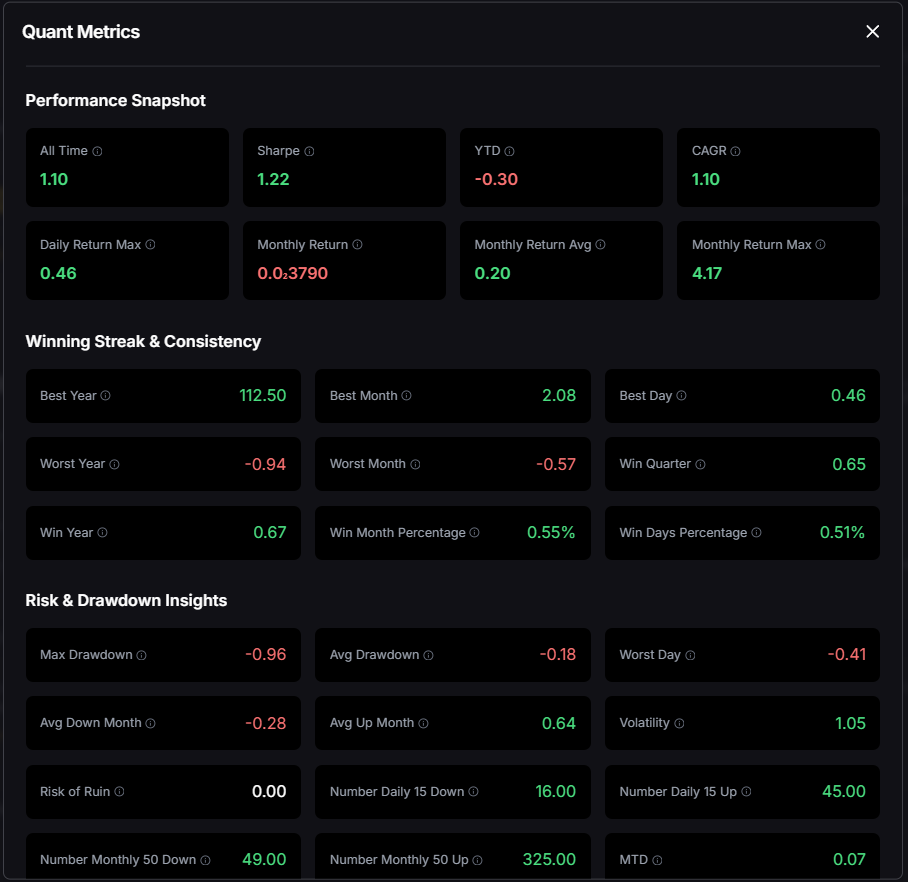
Risk-adjusted truth beats hype. Price alone hides tail risk and whipsaws. Quantmetrics compresses edge, risk, and consistency into metrics that travel across assets and timeframes—so you can rank universes, size positions, and communicate performance like a pro.
Built for dev speed. A clean REST schema, predictable latency, and easy auth mean you can plug Sharpe/Sortino into bots, dashboards, and screeners without maintaining your own analytics pipeline. Pair with caching and batching to serve fast pages at scale.
The Quant Metrics cURL request is located in the top right of the API Reference, allowing you to easily integrate it with your application.
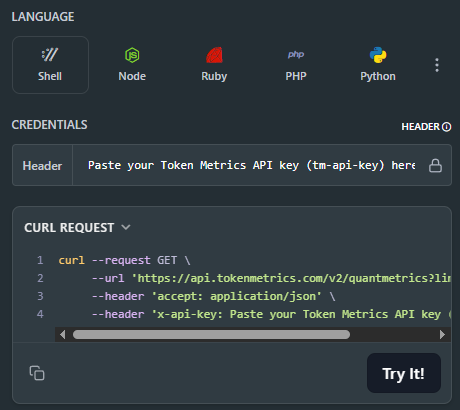
👉 Keep momentum: Get API Key • Run Hello-TM • Clone a Template
Kick off from quickstarts in the docs—fork a dashboard or screener template, plug your key, and deploy in minutes. Validate your environment with Run Hello-TM; when you need more throughput or webhooks, compare API plans.
Quantmetrics computes risk-adjusted performance over a chosen lookback (e.g., 30d, 90d, 1y). You’ll receive a JSON snapshot with core statistics:
Call /v2/quantmetrics?symbol=<ASSET>&window=<LOOKBACK> to fetch the current snapshot. For dashboards spanning many tokens, batch symbols and apply short-TTL caching. If you generate alerts (e.g., “Sharpe crossed 1.5”), run a scheduled job and queue notifications to avoid bursty polling.
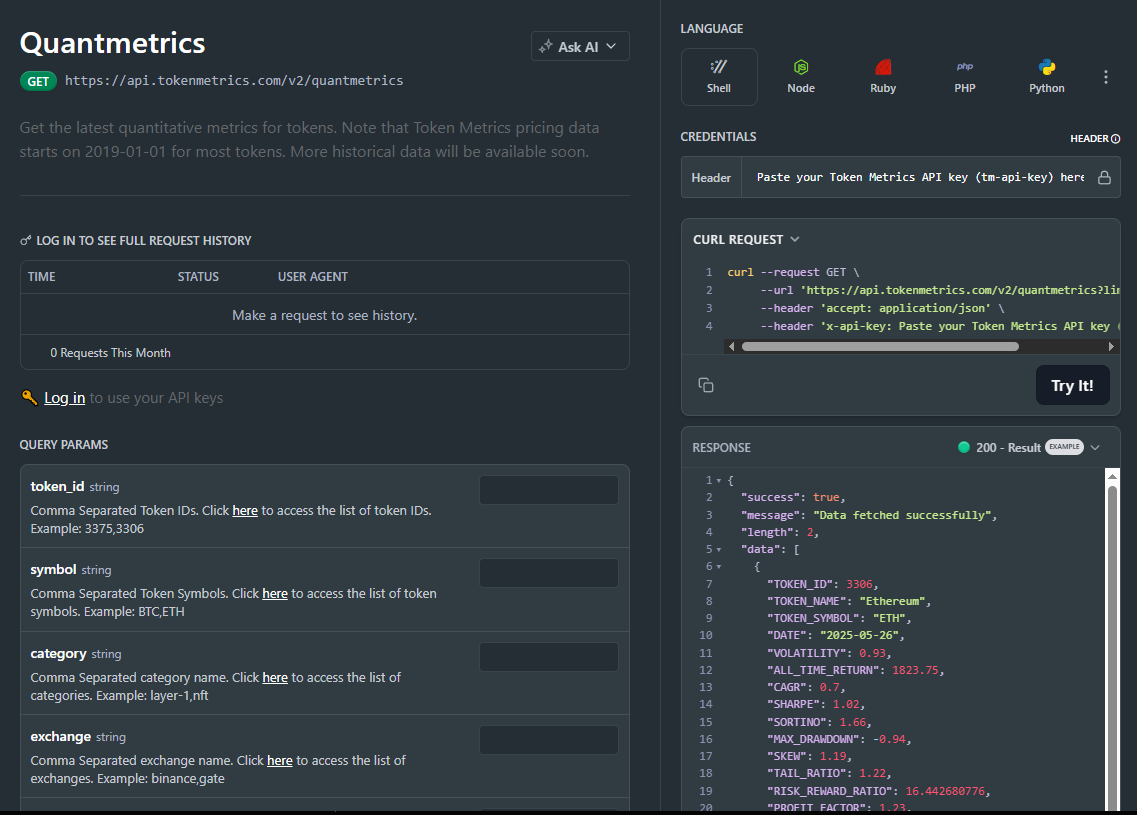
1) What does the Quantmetrics API return?
A JSON snapshot of risk-adjusted metrics (e.g., Sharpe, Sortino, volatility, max drawdown, CAGR) for a symbol and lookback window—ideal for ranking, sizing, and dashboards.
2) How fresh are the stats? What about latency/SLOs?
Responses are engineered for predictable latency. For heavy UI usage, add short-TTL caching and batch requests; for alerts, use scheduled jobs or webhooks where available.
3) Can I use Quantmetrics to size positions in a live bot?
Yes—many quants size inversely to volatility or require Sharpe ≥ X to trade. Always backtest and paper-trade before going live; past results are illustrative, not guarantees.
4) Which lookback window should I choose?
Short windows (30–90d) adapt faster but are noisier; longer windows (6–12m) are steadier but slower to react. Offer users a toggle and cache each window.
5) Do you provide SDKs or examples?
REST is straightforward (JS/Python above). Docs include quickstarts, Postman collections, and templates—start with Run Hello-TM.
6) Polling vs webhooks for quant alerts?
Dashboards usually use cached polling. For threshold alerts (e.g., Sharpe crosses 1.0), run scheduled jobs and queue notifications to keep usage smooth and idempotent.
7) Pricing, limits, and enterprise SLAs?
Begin free and scale up. See API plans for rate limits and enterprise SLA options.

%201.svg)
%201.svg)
Automated trading is reshaping the way traders interact with the crypto markets. For beginners and advanced users alike, building a Python-powered crypto trading bot opens up incredible possibilities—from automating strategies to conducting rapid backtests and executing trades 24/7. But how do you go from a basic script to a robust trading algorithm? This guide walks you through the process, addresses key technical considerations, and illustrates how AI and analytics platforms can make your journey more efficient and insightful.
Python has become the top choice for quantitative finance and crypto automation. Its rich ecosystem of libraries (like ccxt for exchange APIs, pandas for data analysis, and TA-Lib for technical indicators) allows even beginners to build powerful bots.
Every effective crypto bot has several essential building blocks:
Organizing these parts within clean Python classes or modules makes your bot scalable and easier to maintain as your strategy evolves.
Let’s walk through the foundational process of building your first crypto bot with Python. This approach is equally valuable whether you’re a coding newcomer or migrating from manual trading.
This modular workflow sets the groundwork for more advanced automation and risk controls as you gain confidence.
Once you’ve mastered a basic bot, you can enhance its effectiveness dramatically through both software engineering and strategic sophistication:
Successful automation relies on continuous monitoring and refinement. For many, using analytical tools and platforms like Token Metrics can support data-driven hypothesis generation and rapid backtesting.
Operating a crypto trading bot safely involves attention to both cybersecurity fundamentals and regulatory factors:
Consider open-source libraries with active support, or opt for trusted SaaS tools for additional layers of safety and monitoring.
Build Smarter Crypto Apps & AI Agents with Token Metrics
Token Metrics provides real-time prices, trading signals, and on-chain insights all from one powerful API. Grab a Free API Key
A crypto trading bot is a software application that executes predefined trading strategies automatically, buying or selling cryptocurrencies on your behalf using real-time market data.
Basic Python programming—data types, functions, loops, modules—is sufficient for creating simple bots. For advanced features (e.g., machine learning, concurrency), deeper knowledge is helpful but not mandatory at the outset.
Python is widely used and considered secure if best practices are followed, especially regarding API key management and keeping dependencies up to date.
Most major centralized exchanges (like Binance, Coinbase Pro, Kraken, KuCoin) support API-based trading compatible with Python libraries such as ccxt or exchange-specific SDKs.
Yes. You can utilize libraries such as scikit-learn or PyTorch to add AI models for signal detection, predictive analytics, or anomaly detection, enhancing your strategy’s adaptability.
This article is for educational and informational purposes only and does not constitute financial, investment, or trading advice. Always conduct your own research and comply with applicable regulations and best practices when developing or using automated trading bots.

%201.svg)
%201.svg)
The landscape of crypto trading is rapidly evolving, and as we move into 2025, automation through trading bots remains one of the most transformative trends. Both newcomers and experienced traders are turning to crypto trading bots to streamline processes, manage risk, and take advantage of around-the-clock markets. But with the explosion of open source and paid options, how do you identify which bots merit your attention? In this deep dive, we’ll compare the leading crypto trading bots of 2025—balancing tech, usability, and transparency—so you can navigate this essential toolkit with confidence.
Crypto trading bots are software programs designed to automate buying, selling, and portfolio rebalancing in cryptocurrency markets. Leveraging predefined rules, technical indicators, or advanced machine learning, these bots execute trades faster and without the emotional bias that can affect manual trading. Bots can operate 24/7, responding instantly to market changes and often employing sophisticated strategies that would be challenging to replicate manually.
In 2025, the variety of bots available spans from simple rule-based systems to complex AI-driven agents. They connect to crypto exchanges—such as Binance, Coinbase, or Kraken—through API integrations. Most bots allow users to customize strategies, set risk parameters, and monitor performance through intuitive dashboards.
The difference between open source and paid crypto trading bots often comes down to transparency, control, and ease of use.
Choosing between open source or paid options in 2025 depends on your technical skill, needs for customizability, trust level, and budget allocation for trading infrastructure.
As AI integrates deeper into crypto trading, both open source and paid bots have seen an upgrade in intelligence and adaptability:
This evolution assists users at all experience levels, turning AI-powered bots into leading research and automation companions rather than just passive trading engines.
Let’s spotlight a few prominent options, emphasizing their core features without bias:
Each of these solutions appeals to different user profiles and ambitions. Some prioritize full-stack transparency and algorithmic control (the open source camp), while others seek set-and-forget usability, support, and feature-rich tools (the paid category).
Whether you gravitate toward open source innovation or streamlined paid solutions, consider the following best practices:
The right research, careful strategy testing, and a responsible approach to automation ensure bots enhance your trading—not replace foundational knowledge or risk management.
Enhance Your Trading with Token Metrics
Token Metrics offers real-time prices, trading signals, and on-chain insights to help you make informed decisions. Start Trading Smarter Today
Using crypto trading bots is legal in most jurisdictions. However, exchanges may have their own rules, so always review the terms of service for the platforms you use. Compliance with local laws regarding crypto assets is also important.
Most major exchanges provide APIs that allow trading bots to connect and execute trades. However, the level of support and functionalities may vary. Always verify the bot’s compatibility with your chosen exchange.
Not necessarily. Many paid trading bots offer user-friendly interfaces requiring no coding skills. Open source bots often need technical setup and strategy tweaks, so basic programming knowledge can be helpful for those options.
AI-based bots can adapt to changing market conditions and process complex data in real time, offering advantages in dynamic environments. However, success depends on the implementation, underlying data, and usage. Rule-based bots can be more predictable and transparent.
Risks include technical failures, API connection issues, untested algorithms, security breaches, and unpredictable market behavior. It’s important to use secure practices, monitor performance, and regularly audit bot activities.
This article is intended for informational and educational purposes only. It does not constitute investment advice or recommendations of any kind. Always conduct your own research and consult with financial professionals before engaging in any cryptocurrency trading or investment activities.

%201.svg)
%201.svg)
The evolving world of digital assets runs on data. For developers, analysts, and organizations navigating this landscape, harnessing accurate, timely, and actionable crypto data is fundamental to success. But how can you efficiently access vast ledgers, prices, and on-chain analytics from thousands of cryptocurrencies? Enter cryptocurrency APIs—the engines quietly fueling innovation and insight across the blockchain sector.
An API (Application Programming Interface) is a standardized way for software to communicate and exchange information. A cryptocurrency API specifically facilitates seamless access to crypto-related data and functions. Whether dealing with historical prices, blockchain transactions, token metadata, or real-time market feeds, these APIs offer a programmatic gateway into complex digital asset ecosystems. Instead of manual research across multiple platforms, users can automate data collection, run analytics, or even build trading infrastructure—all with efficient, secure calls to an API endpoint.
The emergence of APIs has democratized access to blockchain data, benefiting projects of all sizes. Whether launching a DeFi dashboard, researching token analytics, or simply syncing exchange prices into spreadsheets, APIs are the backbone of digital asset research and development.
Not all crypto APIs are created equal. Various categories reflect the diverse needs of the blockchain community:
The right API opens myriad doors—automating research, developing robust applications, and reducing manual overhead.
Choosing a crypto API isn’t just about the breadth of assets covered. Making a strategic selection involves assessing several core attributes:
Assessing feature sets against your application’s requirements ensures scalability and longevity in rapidly changing markets.
How are cryptocurrency APIs shaping real-world workflows? Here are several practical scenarios:
APIs save time and reduce errors by replacing manual data collection with automated, scalable solutions accessible to both beginners and professionals.
The latest generation of cryptocurrency APIs goes beyond raw data. Powerful platforms leverage artificial intelligence (AI) and machine learning to deliver high-value insights. Examples include:
Access to such data is increasingly accessible through well-documented endpoints and SDKs, enabling teams to build smarter, safer crypto tools and gain market context previously reserved for institutional players.
Build Smarter Crypto Apps & AI Agents with Token Metrics
Token Metrics provides real-time prices, trading signals, and on-chain insights all from one powerful API. Grab a Free API Key
Identify your core needs—price data, trading automation, on-chain analysis—and compare leading providers’ data coverage, reliability, security, and ease of integration. Consider documentation quality and the availability of support or SDKs.
Yes, many providers offer free tiers with core data endpoints, rate limits, and restricted historical depth. Advanced features and higher call volumes often require a paid plan. Always review usage terms before building mission-critical services on free APIs.
Absolutely. Cryptocurrency APIs are widely used to source data for research dashboards, quantitative analysis, AI model training, and visualization platforms. Analytical tools like Token Metrics offer API integration for comprehensive analytics.
Reputable APIs use encryption, token-based authentication, and sometimes allow IP whitelisting. Choose providers with clear security practices, monitor API keys, and avoid sharing them publicly or in client-side code.
Basic knowledge of programming languages like Python or JavaScript, APIs (REST/GraphQL concepts), and JSON/parsing skills are essential. For advanced use cases, familiarity with blockchain concepts and data structures adds value.
This blog post is for informational and educational purposes only. It does not provide financial, investment, or legal advice. Always conduct your own due diligence before building, integrating, or interacting with cryptocurrency technologies or APIs.

%201.svg)
%201.svg)
Reliable and fast access to real-time cryptocurrency price data is crucial for developers, analysts, and crypto enthusiasts. Whether you're building a trading bot, analytics dashboard, or portfolio tracker, integrating a free cryptocurrency price API can unlock powerful insights—without hefty costs or restrictive paywalls.
APIs (Application Programming Interfaces) act as bridges that allow applications to communicate with external data sources seamlessly. A cryptocurrency price API connects your application to third-party services or blockchain data providers, offering up-to-date information like:
Price APIs are particularly popular because they simplify the process of fetching accurate, timestamped data that can be integrated into trading apps, portfolios, alert systems, or research dashboards. Many API providers offer free access tiers, making experimentation and prototyping accessible to all users.
Developers and researchers turn to free crypto price APIs for several compelling reasons:
While free APIs may include usage limits or reduced feature sets compared to premium plans, they’re often sufficient for early-stage projects or low-volume analytics applications.
The rapidly evolving landscape of digital assets means that not all APIs are created equal. When selecting a free cryptocurrency price API, consider these criteria:
Evaluating these features will help you find an API suited to your project’s technical and analytical requirements.
The crypto ecosystem offers numerous well-maintained APIs with free tiers. The following are widely adopted among developers and researchers:
Some projects also offer open-source APIs that can be self-hosted, providing full customization at no cost beyond basic infrastructure.
Integrating a free cryptocurrency price API into your application is typically a straightforward process. Here’s a broad overview, adaptable to most popular APIs:
Many APIs provide SDKs or code snippets to streamline setup, and active communities can assist with troubleshooting and integration tips.
Build Smarter Crypto Apps & AI Agents with Token Metrics
Token Metrics provides real-time prices, trading signals, and on-chain insights all from one powerful API. Grab a Free API Key
Most reputable free APIs offer reliable real-time or near real-time data. However, reliability can vary based on rate limits and geographic access. It’s good practice to use APIs from established providers and review uptime statistics for mission-critical applications.
It depends on each provider’s terms of service. Some free APIs explicitly allow commercial use up to a quota, while others limit usage to personal or academic projects. Always check licensing and attribution requirements before launching an application for public or commercial use.
API keys should never be exposed in client-side code or public repositories. Store keys in environment variables or server-side configuration files, and implement rate-limiting logic where feasible to protect against abuse.
Common restrictions include rate limiting (e.g., limited requests per second or day), reduced historical data coverage, lack of advanced analytics features, or lower priority for support and uptime. For ongoing or high-frequency use, plan for potential upgrades as your needs expand.
Some advanced APIs, such as Token Metrics, offer not only real-time price data but also AI-driven signals, ratings, and on-chain analytics. These insights can be used to augment research and support automated systems, though always review the provider's documentation for specifics.
This article is for informational and educational purposes only and does not constitute investment advice, financial guidance, or a recommendation to buy, sell, or hold any digital assets. Always consult an independent advisor and conduct thorough research before using any crypto service or technology.

%201.svg)
%201.svg)
The digital asset landscape is evolving rapidly, and as we move through 2025, crypto APIs are more powerful—and essential—than ever. Developers, researchers, and businesses alike depend on APIs to access real-time data, execute smart contracts, and integrate blockchain functionalities into their platforms. But with so many options on the market, how do you identify the best crypto API for your needs? In this guide, we'll explore the latest trends shaping crypto API technology, critical factors to consider, and which platforms are leading the way in 2025.
In the early days of cryptocurrency, APIs focused primarily on fetching current prices or facilitating basic trades. Fast forward to 2025, and APIs now serve as the backbone for an expansive range of blockchain and decentralized finance (DeFi) applications. Several trends have fueled this evolution:
The result is a more robust, secure, and developer-friendly API ecosystem—empowering innovative products in trading, analytics, DeFi, and beyond.
With numerous platforms offering crypto APIs, conducting a methodical evaluation is crucial. Here are the main criteria to assess:
Documenting your project requirements—whether you're building a portfolio tracker, AI trading agent, or DeFi dashboard—will make it easier to compare platforms using this framework.
A few platforms continue setting standards for crypto API solutions. While exact needs will vary, below are some of the most recognized in 2025, each offering strengths for different use-cases:
Ultimately, the “best” choice depends on your integration scenario—from simple price widgets to sophisticated AI-powered crypto tools.
AI has become a game-changer for crypto analysis and application development. APIs that offer built-in machine learning, predictive analytics, and anomaly detection unlock new use-cases:
The ideal API in 2025 will combine reliable blockchain access, rich data coverage, robust analytics, and flexible integration—maximizing the power of AI while maintaining the security standards the industry now demands.
Build Smarter Crypto Apps & AI Agents with Token Metrics
Token Metrics provides real-time prices, trading signals, and on-chain insights all from one powerful API. Grab a Free API Key
A crypto API is a set of programmable endpoints that allows developers to interact with cryptocurrency networks, fetch data, and even execute transactions. It’s vital for automating research, trading, reporting, and blockchain integrations in crypto projects.
Consider factors such as data coverage, latency, reliability, security, costs, and documentation quality. Outline your use case—such as portfolio tracking, AI research, or building DeFi apps—and compare platforms based on those needs.
Top-tier APIs implement strong encryption, access keys, and rate limiting. Always vet providers for compliance and review their security documentation before integrating critical applications.
Yes. Many leading APIs in 2025 support AI-driven analytics, from market sentiment scoring to automated trading signals. These tools help researchers and developers make more informed, data-driven decisions.
The Token Metrics API stands out for its AI-powered intelligence, providing advanced trading signals, comprehensive on-chain insights, and seamless integration capabilities for modern crypto and DeFi applications.
This content is for informational and educational purposes only. It does not constitute investment advice or an offer to purchase or sell any financial instrument. Always conduct your own research and consult appropriate professionals before relying on data for critical operations.

%201.svg)
%201.svg)
From real-time trading dashboards to AI-powered portfolio trackers, cryptocurrency APIs are the backbone of the modern digital asset ecosystem. Choosing the right API is essential for reliable data, robust functionality, and secure integration—but with dozens of options, where do you start?
APIs, or Application Programming Interfaces, allow applications to communicate and exchange data efficiently. In the world of crypto, APIs provide access to blockchain data, real-time pricing, transaction history, market analytics, and much more. Their utility extends from simple balance checks to advanced trading bots and on-chain research tools.
Whether you’re a developer, researcher, or business building a crypto product, APIs enable you to integrate critical features without rebuilding from scratch.
No single API fits every use case. It’s important to evaluate potential providers using a structured set of criteria:
Using these filters helps ensure your selection is future-proof as the crypto landscape evolves.
Depending on your goals, you might need a mix of different API types. Here’s a breakdown of common categories and practical examples:
Carefully matching your use case to API type streamlines development and ensures better long-term results.
Excellent documentation is the difference between a smooth integration and endless debugging. When reviewing API providers, consider:
APIs with vibrant developer ecosystems—like those from Token Metrics and other major analytics platforms—tend to innovate and resolve issues quickly.
Security is paramount when accessing financial data and blockchain assets via APIs. Here’s how to assess providers:
A secure, compliant API minimizes operational and reputational risk as your project scales.
Build Smarter Crypto Apps & AI Agents with Token Metrics
Token Metrics provides real-time prices, trading signals, and on-chain insights all from one powerful API. Grab a Free API Key
A crypto API is a set of protocols allowing apps to access and interact with blockchain data, exchange prices, or trading functionality. It’s crucial for building reliable, scalable products in the digital asset space.
Compare APIs by assessing data coverage, documentation, security features, reliability, rate limits, advanced analytics, and pricing. Matching functionality to your use case is key to making the right choice.
Yes, many providers offer free API tiers suitable for development and light use. However, higher request volumes or advanced features usually require a paid plan.
Basic programming knowledge is recommended, as working with APIs often involves code. Some platforms provide low-code options or widgets for easier integration.
AI-driven platforms like Token Metrics can deliver actionable analytics, portfolio scores, and trend detection through easy-to-integrate APIs—empowering both individual and institutional researchers.
This article is for informational and educational purposes only. It does not constitute investment, financial, or legal advice. Always independently verify data sources and API providers before integrating them into your projects.

%201.svg)
%201.svg)
APIs have become the backbone of digital innovation, especially in the fast-paced world of cryptocurrencies. Whether you’re building analytics dashboards, powering trading bots, or simply retrieving up-to-date coin prices, understanding how to use crypto APIs is an essential skill for developers and data enthusiasts alike. This guide breaks down everything you need to know to get started and build effective solutions using crypto APIs.
A crypto API (Application Programming Interface) is a set of digital tools and protocols that allows applications to communicate with cryptocurrency data sources such as exchanges, blockchains, or analytics platforms. With a well-designed API, developers can fetch real-time or historical market data, execute trades, review blockchain transactions, and tap into on-chain insights—all programmatically, without manual intervention. Common use cases for crypto APIs include portfolio tracking tools, market research dashboards, trading bots, and compliance monitoring systems.
There are several factors to consider when selecting a crypto API:
Examples of popular crypto APIs include CoinGecko, CryptoCompare, Binance API, and specialized analytics APIs like Token Metrics.
Once you've selected a crypto API, follow these general steps to integrate and use it:
By starting with a specific analytic or automation goal, then systematically expanding feature use as you learn, you can steadily build robust crypto-powered tools.
Handling financial and market data demands heightened attention to security. Adhere to these best practices when using any crypto API:
Following these protocols can help safeguard your application—and in some scenarios, sensitive wallet or trading information—from common vulnerabilities.
Crypto APIs are used across a spectrum of industries and applications, including:
As both crypto and AI technologies continue to advance, the synergy between API-driven data and algorithmic analysis promises even more powerful applications, from DeFi monitoring to predictive analytics and risk management.
Build Smarter Crypto Apps & AI Agents with Token Metrics
Token Metrics provides real-time prices, trading signals, and on-chain insights all from one powerful API. Grab a Free API Key
Start by defining your data needs—crypto coverage, real-time vs. historical data, and reliability. Compare options by uptime, security, advanced features (like analytics), and cost structure.
Yes. Many developers aggregate data from different APIs to improve coverage or redundancy, but be mindful of integration complexity and API key management.
API keys provide basic access control, but their security depends on your management—keep them secret, never expose publicly, and rotate regularly.
Most crypto APIs are designed for developers, but many tools and platforms let you use APIs with minimal coding. However, basic programming helps unlock their full power.
APIs power trading bots, data dashboards, portfolio trackers, analytics platforms, research tools, compliance monitoring, and AI-driven crypto agents—the possibilities expand with market needs.
This article is for educational purposes only. It does not provide investment advice, trading recommendations, or endorsements. Token Metrics and its authors make no representations regarding the accuracy or suitability of information herein.

%201.svg)
%201.svg)
Building crypto-powered apps, analytical dashboards, or AI trading bots? The backbone of your solution is the API you choose. With dozens of crypto APIs—each promising deep data, speed, and reliability—it’s challenging to determine which is truly best for your development goals. This guide breaks down what to look for in a crypto API, compares leading providers, and offers insights for startups, researchers, and enterprises alike.
At its core, a crypto API (Application Programming Interface) allows apps, platforms, or AI agents to fetch and interact with real-time or historical blockchain and cryptocurrency data. APIs are the bridge between raw blockchain data and accessible, actionable information such as:
Some crypto APIs specialize in data aggregation from exchanges, others in blockchain indexing, and some combine both along with AI-driven insights. Understanding your use case—be it price feeds, portfolio management, compliance, or research—is the first step towards choosing the best fit.
Not all crypto APIs are created equal. Before integrating one into your stack, consider these critical factors:
Several platforms dominate the crypto API landscape, each with specific strengths. Below is an overview of top contenders, their focus areas, and ideal users:
Choosing among these providers often depends on your feature needs. For example, if AI or automated decision-making is a focus, APIs that blend price data with AI-powered analytics (like Token Metrics) can deliver an edge in user experience and automation.
The best crypto API isn’t about “most data”—it’s about empowering your application’s mission. Consider these scenarios:
Emerging AI-powered APIs, exemplified by providers like Token Metrics, now also deliver sentiment analysis, predictive signals, and on-chain behavior analytics useful for both retail and institutional developers.
Narrowing your options comes down to testing—and future-proofing your build:
Ultimately, the “best” crypto API aligns not only with your current requirements but also provides extensibility for tomorrow’s market innovations and compliance standards.
Build Smarter Crypto Apps & AI Agents with Token Metrics
Token Metrics provides real-time prices, trading signals, and on-chain insights all from one powerful API. Grab a Free API Key
Crypto APIs offer a range of data, including real-time prices, historical charts, trading volumes, blockchain transactions, wallet activity, and often on-chain or sentiment analytics. Some also provide trading signals, DeFi protocol data, or NFT analytics based on their focus.
Reputable API providers use encrypted connections and secure authentication. However, it's essential to follow best practices, such as keeping keys private, monitoring usage, and using robust error handling to ensure security and uptime.
Most leading providers (including Token Metrics, CoinGecko, and CoinMarketCap) offer free API tiers ideal for prototyping or hobby projects, though limits may apply to request rates or data depth. Always review free versus paid feature lists before scaling.
APIs that deliver both low-latency price feeds and AI-powered signals—like the Token Metrics API—can enhance the performance and intelligence of AI trading bots. Choose based on the depth of data and analytics you require.
Abstracting API integration in your codebase (using middleware or SDKs) makes it easier to swap providers if needed. Always review new documentation for compatibility, endpoints, and rate limits when transitioning.
This article is for informational and educational purposes only. It does not constitute investment advice or an endorsement of any provider or service. Always conduct independent technical and compliance review before integrating any third-party API.

%201.svg)
%201.svg)
Access to real-time cryptocurrency prices is essential for anyone building apps, research tools, or bots in the crypto space. With countless digital assets and rapid price movements, quality data feeds are in high demand. But is there a free or cheap API that provides real-time crypto prices? In this guide, we break down your options, compare major providers, and explain the trade-offs when looking for budget-friendly API solutions.
Crypto price APIs are services that deliver up-to-the-second market data for cryptocurrencies. These APIs aggregate information from exchanges and other sources, normalize data, and provide endpoints that developers or analysts can programmatically access. They fuel:
The quality of a crypto price API comes down to a few core factors: data accuracy, coverage of exchanges and coins, API uptime, update frequency, latency, and—crucially—price.
Several providers offer a limited API tier at no cost, suitable for prototypes, personal projects, or educational use. Here are some notable free API choices:
These options provide excellent value at zero cost but may be restrictive for commercial apps or high-frequency needs. Free APIs often offer lower rate limits, partial data (vs. real aggregated global prices), and less responsive customer support.
As requirements grow—think higher update frequency, greater reliability, or advanced analytics—free APIs may fall short. Entry-level paid tiers are designed for startups, indie developers, and small teams that find free plans too limiting, yet don’t require enterprise-level solutions. Typical advantages include:
Popular affordable options include:
It's worth evaluating how much "real-time" performance and depth your use case truly requires, as this will inform whether a free, cheap, or more premium tier is necessary.
API selection comes down to both core features and contextual requirements. Consider these checkpoints:
For rapid prototyping, free APIs are great. For mission-critical apps, especially those requiring AI-powered analytics, a paid solution with more advanced features and support might be essential.
Real-time data APIs are integrated in a variety of ways. Developers often:
It's critical to match your API choice with your technical stack and performance needs. Fortunately, competitive options mean even budget-constrained projects can access real-time data. Many tools, such as Token Metrics, layer advanced analytics and AI research over raw price feeds, providing more actionable information for users and researchers.
Build Smarter Crypto Apps & AI Agents with Token Metrics
Token Metrics provides real-time prices, trading signals, and on-chain insights all from one powerful API. Grab a Free API Key
Among free APIs, CoinGecko and Binance are highly regarded for consistent uptime and comprehensive coverage. Still, their free tiers may have lower priority and reduced guarantees compared to paid options.
Real-time typically refers to data updates as soon as they become available, with latencies of under a second to a few seconds. Not all "free" APIs deliver true tick-by-tick price feeds due to technical and cost constraints.
Some free APIs restrict usage to non-commercial applications. Always check provider terms of service before integrating a free API with any monetized product.
Platforms like Token Metrics layer on-chain analytics and AI-powered signals on top of real-time price feeds. This helps advanced users derive deeper insights beyond basic tick data.
Limitations typically include lower request limits, delayed data updates, restricted support, and less comprehensive data sets. For higher volume or critical use, a paid tier may be necessary.
This article is for informational purposes only and does not constitute financial or investment advice. Always conduct your own research and consult relevant legal and compliance guidance before integrating third-party APIs or building crypto-related tools.


 Create Your Free Account
Create Your Free Account9450 SW Gemini Dr
PMB 59348
Beaverton, Oregon 97008-7105 US
.svg)




.png)
Token Metrics Media LLC is a regular publication of information, analysis, and commentary focused especially on blockchain technology and business, cryptocurrency, blockchain-based tokens, market trends, and trading strategies.
Token Metrics Media LLC does not provide individually tailored investment advice and does not take a subscriber’s or anyone’s personal circumstances into consideration when discussing investments; nor is Token Metrics Advisers LLC registered as an investment adviser or broker-dealer in any jurisdiction.
Information contained herein is not an offer or solicitation to buy, hold, or sell any security. The Token Metrics team has advised and invested in many blockchain companies. A complete list of their advisory roles and current holdings can be viewed here: https://tokenmetrics.com/disclosures.html/
Token Metrics Media LLC relies on information from various sources believed to be reliable, including clients and third parties, but cannot guarantee the accuracy and completeness of that information. Additionally, Token Metrics Media LLC does not provide tax advice, and investors are encouraged to consult with their personal tax advisors.
All investing involves risk, including the possible loss of money you invest, and past performance does not guarantee future performance. Ratings and price predictions are provided for informational and illustrative purposes, and may not reflect actual future performance.

